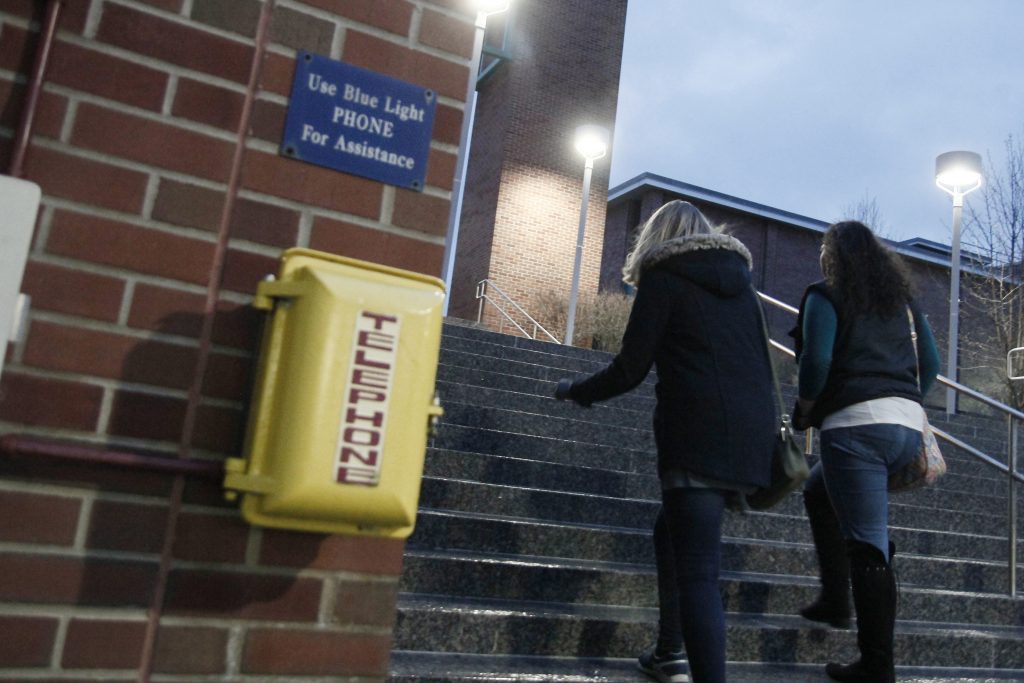
The blue-light phones that illuminate Binghamton University’s campus will now brighten neighborhoods on the West Side, thanks to a recently announced collaboration between the BU administration and the city of Binghamton.
In his State of the City address last week, Binghamton Mayor Rich David revealed that blue-light phones and street cameras will be placed in West Side neighborhoods south of Main Street, where many students reside. The blue-light system, which is utilized on college campuses nationwide, connects users directly to the University Police Department through phones attached to the highly visible light posts. BU currently has 82 of these call boxes placed in strategic locations throughout campus, including roadways, residence halls and parking lots.
Unlike the phones on campus, those located on the West Side will put users in contact with the Binghamton Police Department. The announcement came shortly after the city secured a funding commitment of $200,000 per year for at least five years from the University. According to David, the concept of installing these safety measures had been explored for several years before the necessary funds were obtained. While BU will foot the bill for the foreseeable future, David discussed the possibility of using impact aid in the future.
“Impact aid basically means is that the state of New York is considering giving additional state funding to cities that house large university centers,” David said. “It is basically additional money that would help offset the cost of providing services: police, fire, public works, etc. It is something that has not been approved yet in this state.”
Although the initiative will be funded by the University, its goal is to improve safety for everyone living on the West Side — not just students.
“[These measures] will create safe walking routes for students and deter criminal activity for everyone in those neighborhoods,” David said.
Concerns about student safety are not unfounded. Last February, three students were assaulted near the intersection of Hawley and Exchange streets in Downtown Binghamton. A week later, a student was assaulted and his cellphone was stolen on Oak Street on the city’s West Side.
The exact locations of the lights and cameras have yet to be determined, but the city plans to place them in areas with high levels of student traffic. Installation is set to begin in the coming months and should be complete by the start of the fall 2017 semester. Once the measures are in place, a task force of University and city officials will convene regularly to review how the upgrades are being utilized and provide recommendations for future uses of the funding.
According to Ryan Yarosh, BU director of media and public relations, undergraduate and graduate students, as well as professional staff from the Division of Student Affairs and Division of Operations, will represent the University on this committee. Councilman Joseph Mihalko represents the second district, which encompasses part of the West Side, and will also serve on the committee. Mihalko expressed his support for the initiative.
“I’m definitely in favor of it,” he said. “There’s no question about it. Anything with safety or security for students — or any resident walking around the streets — is a great idea.”
The implementation of a blue-light system in student sectors was one of the main safety objectives outlined by the Roosevelt Institute, a BU student group dedicated to student-crafted progressive policy, in its Binghamton Blueprint 2016: Rewriting the Rules of Broome County.
Brianna Cea, the president of the organization and a sophomore double-majoring in political science and philosophy, politics and law, sees the project as a necessary resource.
“This initiative will improve safety for students and residents living in downtown Binghamton and the West Side by providing an emergency response mechanism for victims of crime, such as theft or assault,” she wrote in an email. “I know victims of such attacks, who had their phone and wallets stolen, and were unable to immediately get help.”


